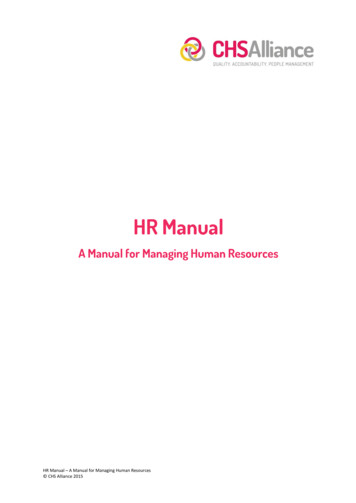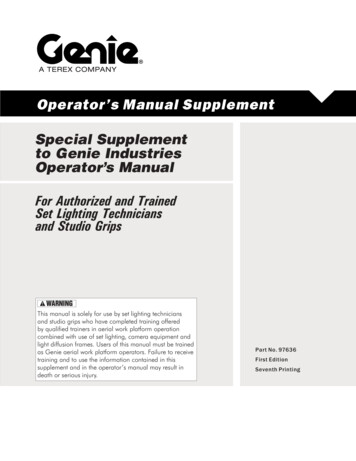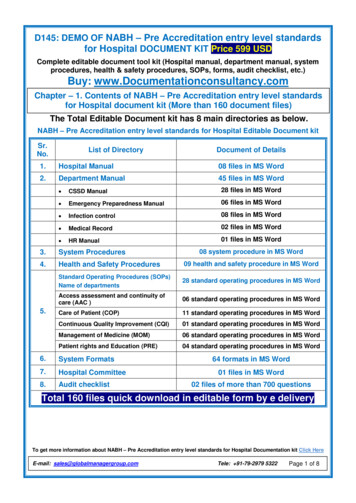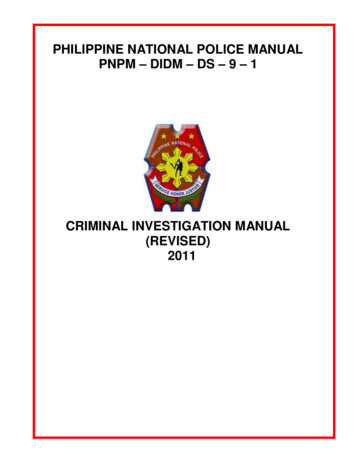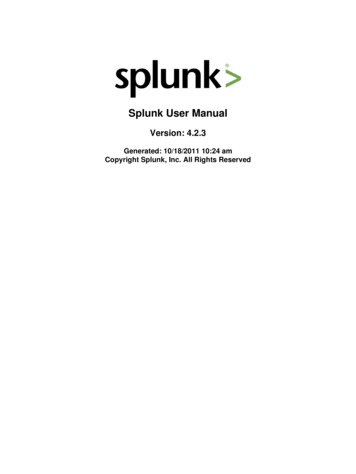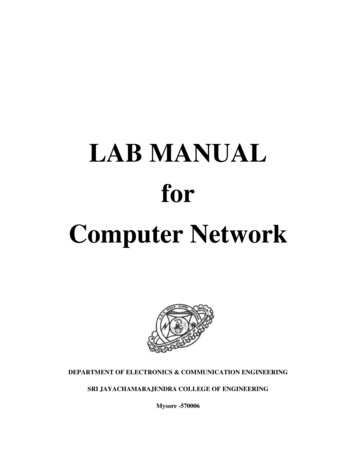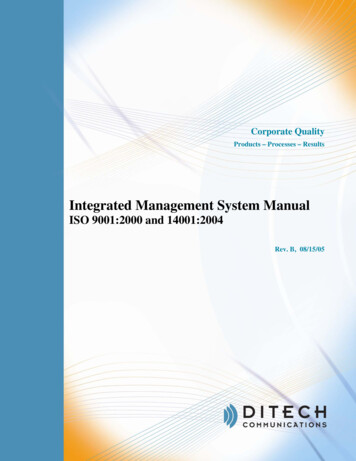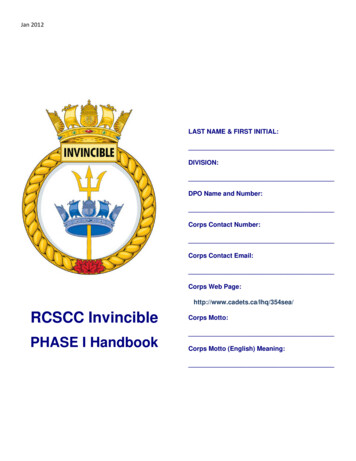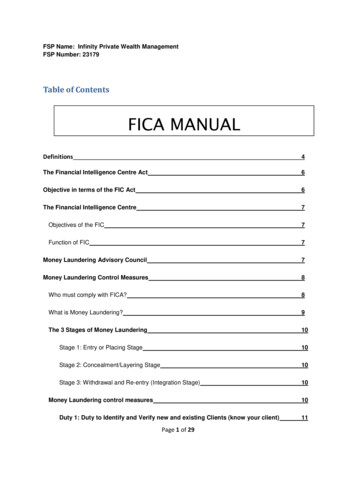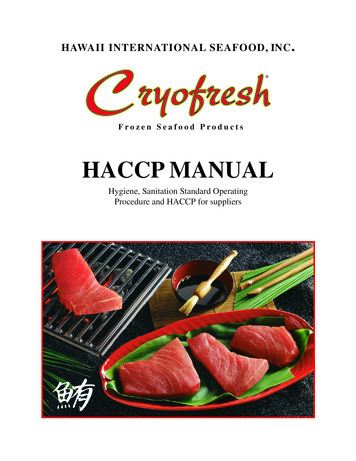
Transcription
HAWAII INTERNATIONAL SEAFOOD, INC . Frozen Seafood ProductsHACCP MANUALHygiene, Sanitation Standard OperatingProcedure and HACCP for suppliersSummer 1999
Prepared For:Cryofresh manufacturing facilities are audited by the NationalMarine Fisheries Services (NMFS), Seafood Inspection Program,to verify compliance with the following applicable standards: USFDA HACCP EU (European Union) TSSA Tasteless Smoked Seafood AssociationCopyright October 1999Contents from this document may not be reproduced in whole or in part without the expressed writtenconsent of Hawaii International Seafood, Inc.Page I
HACCP MANUALI. Table of ContentsPage 1. Table of ContentsPage 2. IntroductionPage 2. Personal HygienePage 2. Photo # 1. Workers Using Masks and Gloves.Page 3. Example IIIA: Personnel Hygiene CodePage 3. Sanitation Standard Operating ProcedurePage 4. Photos # 2 and # 3. Ice Potability and Thermometer ChecksPage 7. Cleaning SchedulePage 7. HACCP PlanPage 8. Photo #5 and #6 Packaging Material HandlingPage 9. Example: SSOP plan.Page 11. Example: Calibration ChecklistPage 12. Example: Chlorine Checklist and Glass ChecklistPage 13. Cleaning SchedulePage 13. Example: Map, Facility Areas of ResponsibilityPage 14. Example: Cleaning InstructionsPage 32. Example: Cleaning Schedule Check ListPage 37. Example: Hazard Analysis WorksheetPage 40. Typical HACCP Plan and RecordsHawaii International Seafood, Inc. is a Charter Member and CertifiedManufacturers Member of the Tasteless Smoked Seafood Association(TSSA). The TSSA establishes strict standards and auditing proceduresto “CERTIFY” products manufactured with “tasteless smoke” and toverify complaince of tasteless smoked products with USFDA food safetyand labeling requirements.Page 1
HACCP MANUALHACCP MANUALII. IntroductionIII. Personal HygieneThe people at Hawaii International Seafood Inc. (referredto in this Manual as H.I.S.) are dedicated to providingconsistently high quality and safe seafood products. Forthis reason we have written this manual as a guide forour international suppliers. We are dedicated to workingclosely with our suppliers to achieve our goal of exceeding international standards for hygiene, sanitation andhazard control in each facility that produces seafood products for H.I.S. This manual is also available on requestfrom H.I.S. on diskette formatted to MS Word for Windows 95, 98 or 2000.All H.I.S. suppliers shall adopt and maintain a Personnel Hygiene Code and training program at each site whereH.I.S. products are produced. In-house training on thePersonnel Hygiene Code for all staff shall be conductedby qualified management personnel at least annually andindividually each time a new staff member is acquired.This manual clearly explains the requirements all suppliers must meet and includes actual examples of thedocuments and records currently in use by our U.S.D.C.and U.S.F.D.A. inspected facilities worldwide.We require that all suppliers meet the minimum requirements as stated in this manual. For this purpose, the word“shall” is used to indicate mandatory requirements andthe word “should” is used to indicate suggestions fromH.I.S.In addition to the requirements set forth in this manualall suppliers shall: Meet or exceed all local Federal, Provincial and /orState health and safety codes for the jurisdiction wheretheir facility is physically located. Be fully aware of and abide by Good ManufacturingPractice for all production operations.Personnel Hygiene Code training shall consist of thorough and complete orientation and explanation of thePersonnel Hygiene Code to all staff members. This training shall be documented for each staff member by theissuance by the supplier of an in-house Certificate ofCompletion for training on the Personnel Hygiene Codefor each individual staff member. This Certificate ofCompletion should be issued only after the individualstaff member has passed an oral or written test on thePersonnel Hygiene Code.The Personnel Hygiene Code example that follows thispage represents the minimum standards required of allsuppliers of seafood products for H.I.S. See exampleIII-A on following page.Note on Surgical Masks and Gloves: Surgical masksand gloves, although not required by H.I.S., may be usedat the option of the supplier. If they are used they shallbe 100% disposable and disposed of each time the individual staff member exits the processing room in whichthey are used. In addition, gloved hands shall be washedas required in the Personnel Hygiene Code prior to putting on gloves and again after the gloves are on. Never under any circumstances export any product produced outside of the guidelines contained in this Manualto H.I.S. without full notice in writing to H.I.S. and theexpress written permission of H.I.S. Produce product only with full regard to environmental, ethical and occupational safety concerns. Be prepared and available for unannounced auditvisits by authorized H.I.S. representatives. Including,but not limited to, maintaining copies of all requireddocuments and records in readily accessible form atthe actual plant site or sites where H.I.S. products areproduced. Maintain at least one copy of this manual, in goodcondition, at the actual plant site or sites where H.I.S.products are produced.PHOTO #1. Workers using masks and gloves. Proper protectiveclothing shall be worn by all personnel in the processing area.Disposable surgical masks and gloves may be used at the option ofthe supplier, but must be used properly.Page 2
EXAMPLE III-A Personal Hygiene CodeHACCP MANUAL1. All personnel entering the receiving or processingareas shall wear the approved protective uniform.IV. Sanitation Standard OperatingProcedureThe processing area uniform shall consist of rubberboots, white smock and white hair-net cap, whitehair net beard snood and mustache snood if applicable.2. Protective clothing shall be worn only immediatelyprior to entering or while working in the areadesignated for its use.Protective clothing shall not be worn outside thearea designated for its use, especially in the eating/smoking area, outside the facility or in the bathrooms.Protective clothing shall be turned in at the end ofeach work shift for in-house laundering.Protective rubber boots shall not be worn outsidethe facility.Each H.I.S. supplier shall write and maintain a plan forSanitation for each facility that produces seafood products for H.I.S. As required by both U.S.F.D.A. and theE.E.C. this plan shall be titled “Sanitation Standard Operating Procedure” (SSOP).The SSOP, at a minimum, shall cover the following sanitation concerns: Pest Control Facility Structure and Layout Facility Maintenance Cleaning and Sanitizing of All Processing Areas andEquipment Personnel Hygiene3. Personnel hair and facial hair shall be fully enclosed within the hair-net cap or facial hair snoodwhile in the processing area. Toilet Facilities4. No jewelry shall be worn in the processing area. Chemicals (Including Chlorine Levels in SanitizingSolutions) Potable Water and Ice Supply5. No perfume or body scent shall be worn by processing personnel. Ventilation6. Fingernails shall be kept short, neat and clean. Waste Disposal7. All wounds cuts, sores, infections or abrasionsshall be reported to the office and covered withdisposable sanitary bandage material. Measuring Equipment Calibration8. All personnel must thoroughly wash their handsand rinse them with chlorine dip (water chlorinatedto 50 PPM) or other H.I.S.-approved sanitizer eachtime they enter a food-contact area.These concerns shall be addressed in detail in writing inwritten form in the SSOP and checked daily using anSSOP Checklist that covers these concerns as written inthe SSOP. This SSOP and SSOP Checklist shall be verified and audited by an authorized H.I.S. technician. Awritten copy of the SSOP and all related records shall bekept in readily accessible form at the actual plant site orsites where H.I.S. products are produced.9. Smoking and eating shall only be allowed in thedesignated rest area.10. Any personnel suffering from infectious disease,including flu, stomach complaints or food poisoning shall report to the office for evaluation prior toreturning to work11. No glass in food-contact areas. Glass StatusPlease see examples IV-A and IV-B on the pages following Photographs 2 and 3. This is an actual SSOP andSSOP Checklist currently in use in a USFDA and USDCinspected facility that supplies both fresh and frozen products to H.I.S.Page 3
EXAMPLE IV-A Sanitation StandardOperating Procedure1. Sanitation Concern: Pests1.1 Eliminate harborage and attractantareas for pests. Method: Designated management and/or processingpersonnel shall keep weeds cut, pick up litter onfacility grounds and keep area clean and free ofharborage areas for pests. Method: Designated management and/or processingpersonnel shall conduct daily survey of facility anddispose of any unused/discarded equipment andmaterials that may become harborage areas for pests. Method: Designated management and/or processingpersonnel shall eliminate standing pools of water onfacility grounds through drainage or manually on adaily basis as allowed by weather. The above methods shall be listed on the SanitationChecklist and checked daily for satisfactory statusby the designated management and/or processingpersonnel.PHOTO # 3. Sanitation standards must be maintained throughouteach step of production, from harvest vessel to final packing andcold storage. Method: All non-product-contact areas and surfacesshall be treated with a non-persistent insecticideweekly to eliminate insect pests. All product-contactequipment and surfaces shall be covered or isolatedduring insecticide application. Alternatively, thisshall be contracted to a licensed pest control company. The above methods shall be listed on the SanitationChecklist and checked daily for satisfactory status bydesignated management and/or processing personnel.1.2 Extermination of Pests Method: An insect electrocution device shall beinstalled at the entrance of the processing plantwithin the first entry door and shall be properlymaintained. Method: Traps or poison bait shall be set out andchecked on a daily basis by designated managementand/or processing personnel or as needed and recommended by a licensed pest control company to helpcontrol rodents.2. Sanitation Concern: Structure and Layout ofProcessing Plant2.1 Plant shall be in such a condition so as toprevent filth contamination from entering plant.(i.e. tracked in mud, airborne dust etc.) Method: Management shall ensure that the processing plant is cleaned and sanitized on a twice-dailybasis by designated management and/or processingpersonnel. The above methods shall be listed on the SanitationChecklist and shall be checked daily for satisfactorystatus by designated management and/or processingpersonnel.PHOTO #2. All water andice used throughout eachphase of product handlingshall meet World HealthOrganization Standards forPotable Water.2.2 The design, layout and materials used in theprocessing plant and employee rest rooms shall beable to be readily cleaned and sanitizedto preclude contamination. Method: Rooms shall be laid out and processingfurniture placed so that they can be readily cleanedand sanitized at least twice daily.Page 4
Method: Walls and floors shall be waterproofed andwashable so as to be easily cleaned and sanitizeddaily. The above methods shall be listed on the SanitationChecklist and checked daily for satisfactory status bydesignated management and/or processing personnel.2.3 Equipment and utensils shall be designed andlocated in such a way as to facilitate daily cleaningand sanitation by designated management and/orprocessing personnel.3 Maintenance. The general condition of thefacility shall be maintained to prevent the introduction of hazards. Method: The general condition of the facility shallbe checked on a weekly basis by the plant manageror the designated assistant manager, who will checkfor such things as peeling paint, roof leaks, loosewiring, unsecured wall panels and the like. Repairsand upkeep shall be ongoing and of a preventativenature. Method: Lights shall be covered to prevent physicalcontamination of the product. Method: Equipment shall be maintained and kept ingood working order. Scales shall be checked againsttested weights and thermometers against 0( ice waterdaily. Cooler refrigerators shall be monitored forproper cooling temperatures. Method: All crew members shall hose down theequipment walls, floors and product contact surfacesof the processing area with clean water every day toremove loose debris. A foaming detergent agent shallbe used in conjunction with the wash down procedure. All floors, walls, sinks, drains and tables shall berinsed with water chlorinated to 50 ppm. Thiswater shall be left on all surfaces for 30 minutesprior to being rinsed off with clean water. Method: Walls, floors and equipment shall bethoroughly rinsed with clean water after 30 minutesoaking process in order to rinse off all chemicals, toprevent chemical contamination of the product bycleaning agents and to sanitize all surfaces. Method: Refrigerated storage areas shall be cleanedand sanitized every month in the manner describedabove, or more frequently as required. Method; All other areas of the facility shall beregularly cleaned and kept free of litter and excessclutter by designated management and/or processingpersonnel. The above methods shall be listed on the SanitationChecklist and checked daily for satisfactory statusby designated management and/or processingpersonnel. All requirements for chlorine levels shall be checkeddaily and results entered on the Chlorine LevelChecklist. The above methods shall be listed on the SanitationChecklist or the Calibration Checklist andchecked for satisfactory status on a daily basis bydesignated management and/or processing personnel.4.2 Chemical Contamination Prevention
inspected facility that supplies both fresh and frozen prod-ucts to H.I.S. PHOTO #2. All water and ice used throughout each phase of product handling shall meet World Health Organization Standards for Potable Water. PHOTO # 3. Sanitation standards must be maintained throughout each step of production, from harvest vessel to final packing and cold storage. Page 4 EXAMPLE IV-A Sanitation .
